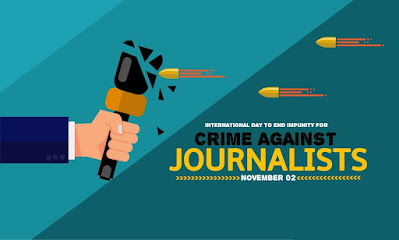2025 Theme: “Truth Unchained: Justice for Journalists, Justice for All”
✍️ Why This Day Matters
On 2 November each year, the world observes the International Day to End Impunity for Crimes Against Journalists, established by the United Nations General Assembly in 2013. This date commemorates the assassination of two French journalists in Mali on 2 November 2013, symbolizing the risks media professionals face while carrying out their duty to inform.
Journalists are the voice of the voiceless. Yet across the globe, reporters face threats, imprisonment, censorship, violence—and too often, death. What is worse? In 9 out of 10 cases, the killers of journalists go unpunished. Impunity not only endangers individual journalists but undermines the very fabric of democracy and the public's right to know.
🎯 2025 Theme: “Truth Unchained: Justice for Journalists, Justice for All”
The 2025 theme focuses on liberating the truth from fear, silence, and systemic violence. It reminds governments, institutions, and the public that ending impunity is not optional—it’s essential for upholding freedom, transparency, and human dignity.
This year’s campaign highlights:
-
Legal reforms for press protection
-
Cross-border cooperation on journalist safety
-
Justice mechanisms to prosecute crimes
-
Mental health support and safety tools for reporters
-
Recognition of local journalists, who are often the most at risk
📊 Stark Realities
-
Over 1,600 journalists have been killed worldwide in the last two decades.
-
In 2024 alone, 70+ journalists were killed, and many more imprisoned, abducted, or assaulted.
-
Women journalists face increasing threats, including online harassment and gender-based violence.
-
Local reporters are more likely to be targeted—and less likely to receive international support.
(Source: UNESCO, CPJ)
🖼️ Artistic Reflection: When the Pen is Silenced
At CRA ARTS, we honor storytellers who risk everything to speak truth to power. Artistic expression can serve as both remembrance and resistance:
-
🎨 Canvas Work: A broken pen lying beside a microphone—bleeding ink, not blood.
-
🖋️ Typography Art: Bold visuals using censored headlines and redacted reports as design elements.
-
📸 Photo Art Collage: Faces of fallen journalists framed by headlines they never got to finish.
-
🕯️ Installations: A typewriter with burned pages representing stories lost to fear and violence.
✊ How to Observe and Act
-
📢 Raise awareness: Share stories of courageous journalists around the world.
-
📰 Support free press: Subscribe to independent media, especially in underrepresented regions.
-
🎤 Host events: Organize or attend webinars, panel talks, or public art exhibitions.
-
📷 Create art that honors journalism and speaks against censorship.
-
🕯️ Light a candle or share a digital vigil in memory of fallen media workers.
Use hashtags like #EndImpunity, #JusticeForJournalists, #PressFreedom, and #TruthUnchained.
🕊️ Final Thought: Justice Is the Shield of Truth
Silencing a journalist does not silence the truth—it only delays it. Every voice matters. Every report has weight. Every silence costs something.
As artists, educators, and citizens, let us defend those who defend the truth. Justice for journalists is justice for democracy.
🌐 Explore more meaningful reflections, cultural insights, and art-led awareness campaigns on my blog:
👉 CRA ARTS Blog — https://craarts.blogspot.com

Comments
Post a Comment